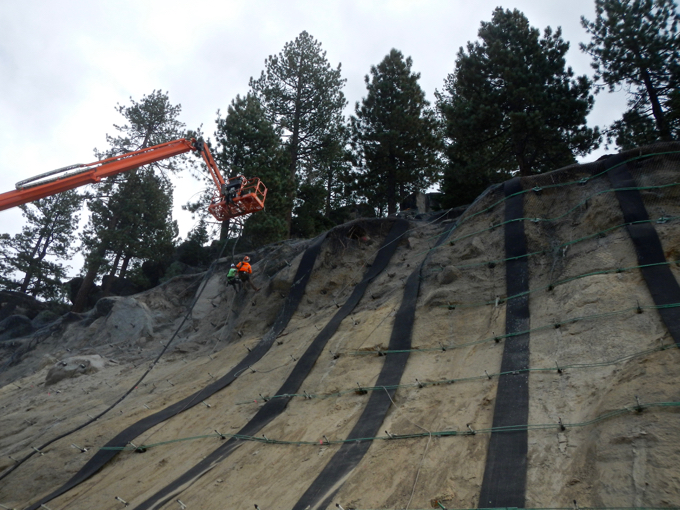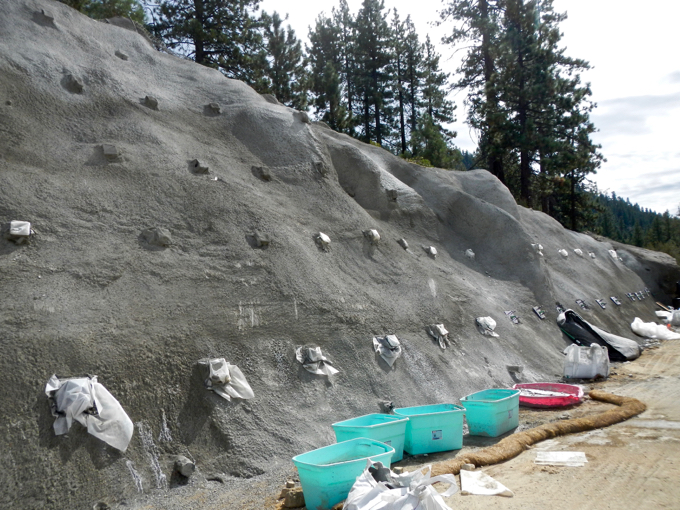NDOT essentially rebuilding slope above Hwy. 50

Men in climbing harnesses secure a wire mesh to the hillside above Highway 50 near Logan Shoals. Photo/Kathryn Reed
By Kathryn Reed
LOGAN SHOALS – While it looks like NDOT is building a climbing wall along Highway 50 on the South Shore, the reality is workers are attempting to stop Mother Nature.
Boulders, some the size of trucks, repeatedly tumbled down last winter onto the road. No cars were hit; no one was injured. The highway – the main artery from the South Shore to Carson City as well as the fastest route to Kings Beach and Incline Village – was closed for weeks, then reduced to one-lane in each direction as it is now.
While the work will not be done this construction season, the plan is to have all the lanes open before winter. Crews are expected to complete the project next year. As long as temperatures don’t get too cold, work will continue this month.
By the time it’s finished, the goal is the average motorist won’t know that the hillside has essentially been rebuilt. Concrete will be contoured to look like natural Sierra granite boulders. “Cracks” will be added to resemble authentic fissures. The stain will also be slightly varied to complement Mother Nature.
Touching a sample, it feels a bit like granite and not like typical concrete. It looks real as well.
The contractor had to pour 4-inch and 12-inch deep samples, as well as provide a test of the finished product for Nevada Department of Transportation officials.
“The design is considered to be a permanent fix. Drainage features let the water in if there is any,” Shawn Paterson, designer with NDOT, told Lake Tahoe News.

A section of the hillside with the 4-inch concrete spray and limited contouring. Photo/Kathryn Reed
There will be multiple layers of reinforcement applied to the hill.
John Angel, resident engineer with NDOT, said the only thing that could pose a problem is road salts because “that degrades concrete.” Still, the state officials are confident the materials will last essentially forever unless there is a catastrophic event like a major earthquake – then all bets are off.
It’s water that brought down the gargantuan boulders – specifically the unusual amount of rain the basin received last winter.
Geo-textile fabric has been laid on the slope from the top to the bottom. Corrugations on the inside will help push the water away. It is designed not to freeze.
PVC pipe is attached at the bottom to let the accumulated water drain.
John Bradshaw, an NDOT designer, explained that the rain washes away the dirt that is the natural interlocking mechanism between the rocks. This makes for a precarious situation, where the stability of neighboring rocks is questionable.
With the assistance of a geotechnical engineer, NDOT studied the whole area. Soil nailing is the solution that the department settled on. This same technology has been used on Highway 28 where the bike trail in Incline Village is being built.
At the steepest, the crews go up 70 feet to the end of NDOT’s right-of-way. The length is more than 1,300 feet. Above their responsibility the land is either private or owned by the U.S. Forest Service.

The drill used to bore 20-foot holes into the hillside that will be filled with concrete as a stabilizer. Photo/Kathryn Reed
To essentially rebuild the slope requires men to be in climbing harnesses eight hours a day. They dangle above the asphalt grouting the holes.
Six-inch-wide holes have been drilled 20-feet-deep into what was described as good soil, and granite so it will be stable. They are spaced 5 feet apart in height and width in a grid pattern. They are filled to become the anchors. They are encapsulated in cement grout, with triple corrosion protection.
Wire mesh is draped over the surface to help hold any loose rocks. It’s then connected to the steel rods.
Shotcrete has already been blown onto a section on the west end of the construction site. This is the 4-inch layer. Anchors protrude from this layer of concrete. On top another 12-inches of shotcrete will be sprayed on. This is similar to what took place on Cave Rock recently when NDOT contractors secured that rock structure.
By next summer NDOT hopes it will be hard to tell crews were ever out there.